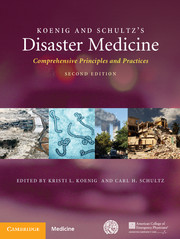Book contents
- Koenig and Schultz's Disaster MedicineSecond Edition
- Dedication
- Koenig and Schultz's Disaster Medicine
- Copyright page
- Contents
- Contributors
- Foreword
- Perspective
- Preface
- Part I Conceptual Framework and Strategic Overview
- Part II Operational Issues
- Part III Clinical Management
- Subpart IIIA: CBRNE and HAZMAT
- 29 Explosive Events
- 30 Burn Disaster Management:
- 31 Clinical Aspects of Large-Scale Chemical Events
- 32 Biological Events
- 33 Radiation Accidents and the Medical Management of Acute Radiation Injury
- 34 Hazardous Material, Toxic, and Industrial Events
- Section IIIB: Environmental Events
- Index
- References
33 - Radiation Accidents and the Medical Management of Acute Radiation Injury
from Subpart IIIA: - CBRNE and HAZMAT
Published online by Cambridge University Press: 05 April 2016
- Koenig and Schultz's Disaster MedicineSecond Edition
- Dedication
- Koenig and Schultz's Disaster Medicine
- Copyright page
- Contents
- Contributors
- Foreword
- Perspective
- Preface
- Part I Conceptual Framework and Strategic Overview
- Part II Operational Issues
- Part III Clinical Management
- Subpart IIIA: CBRNE and HAZMAT
- 29 Explosive Events
- 30 Burn Disaster Management:
- 31 Clinical Aspects of Large-Scale Chemical Events
- 32 Biological Events
- 33 Radiation Accidents and the Medical Management of Acute Radiation Injury
- 34 Hazardous Material, Toxic, and Industrial Events
- Section IIIB: Environmental Events
- Index
- References
- Type
- Chapter
- Information
- Koenig and Schultz's Disaster MedicineComprehensive Principles and Practices, pp. 544 - 578Publisher: Cambridge University PressPrint publication year: 2016



